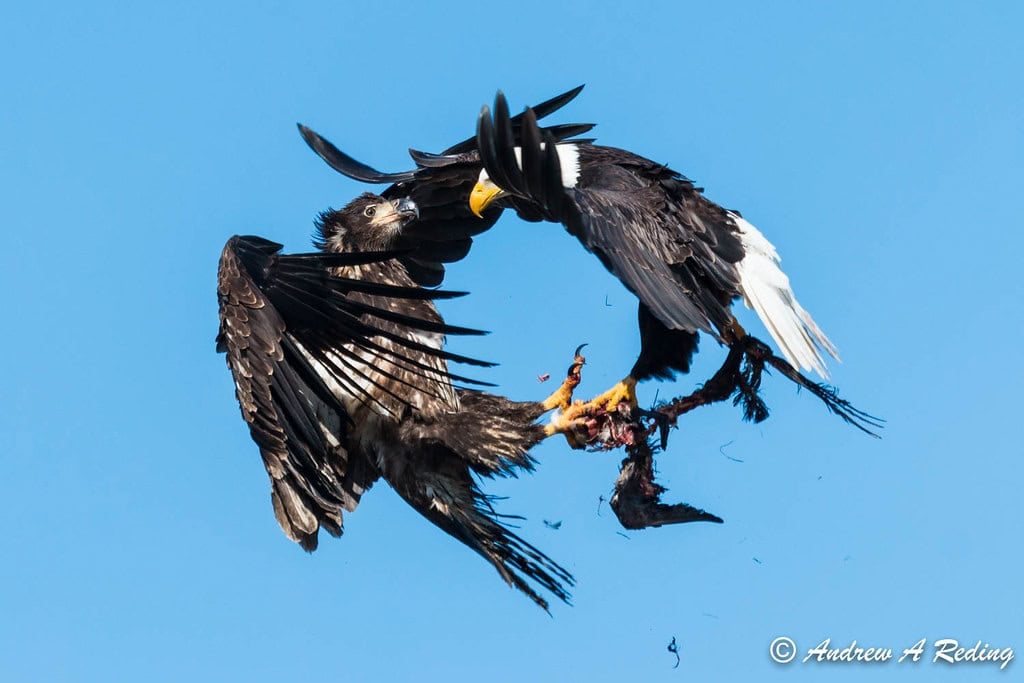The majestic bald eagle, America’s national symbol, is renowned for its impressive aerial abilities and fierce demeanor. While we often admire these magnificent birds soaring peacefully across the sky, there are dramatic moments when eagles engage in aerial combat. These confrontations are not just random acts of aggression but complex interactions governed by territorial instincts, mating behaviors, and survival strategies. When bald eagles fight in the sky, they display some of the most spectacular and intense avian combat in the natural world. From their tactical approaches to the physical techniques employed, these aerial battles reveal fascinating aspects of eagle behavior and social dynamics. This article explores what happens during these high-flying confrontations and why they occur in the first place.
The Reasons Behind Aerial Combat
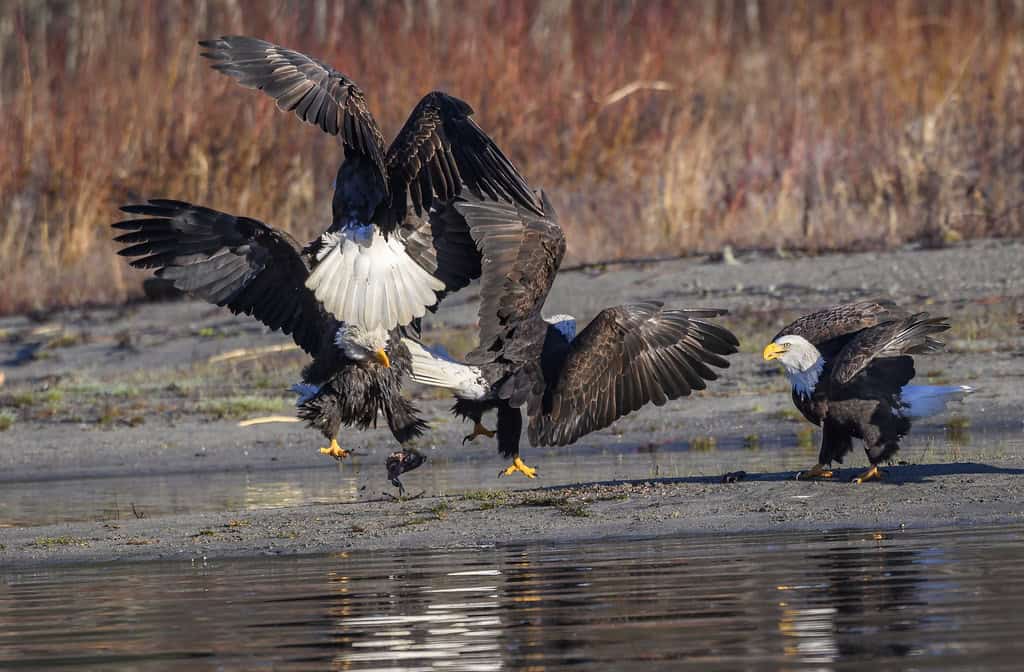
Bald eagles primarily engage in aerial combat for three main reasons: territory defense, competition for food resources, and mating disputes. Territorial conflicts are perhaps the most common, as bald eagles are highly territorial birds, especially during nesting season. A mated pair will aggressively defend an area ranging from 1 to 2 square miles surrounding their nest site, attacking any intruding eagles that venture too close.
Food-related conflicts are also frequent, particularly at communal feeding grounds like salmon runs or areas with abundant carrion. When resources are concentrated, multiple eagles may converge, leading to competitive interactions. During mating season, male eagles might fight over potential mates or nesting territories, while established pairs may work together to drive off rivals. Understanding these motivations helps explain the timing and intensity of eagle conflicts observed in the wild.
Prelude to Battle: Warning Displays
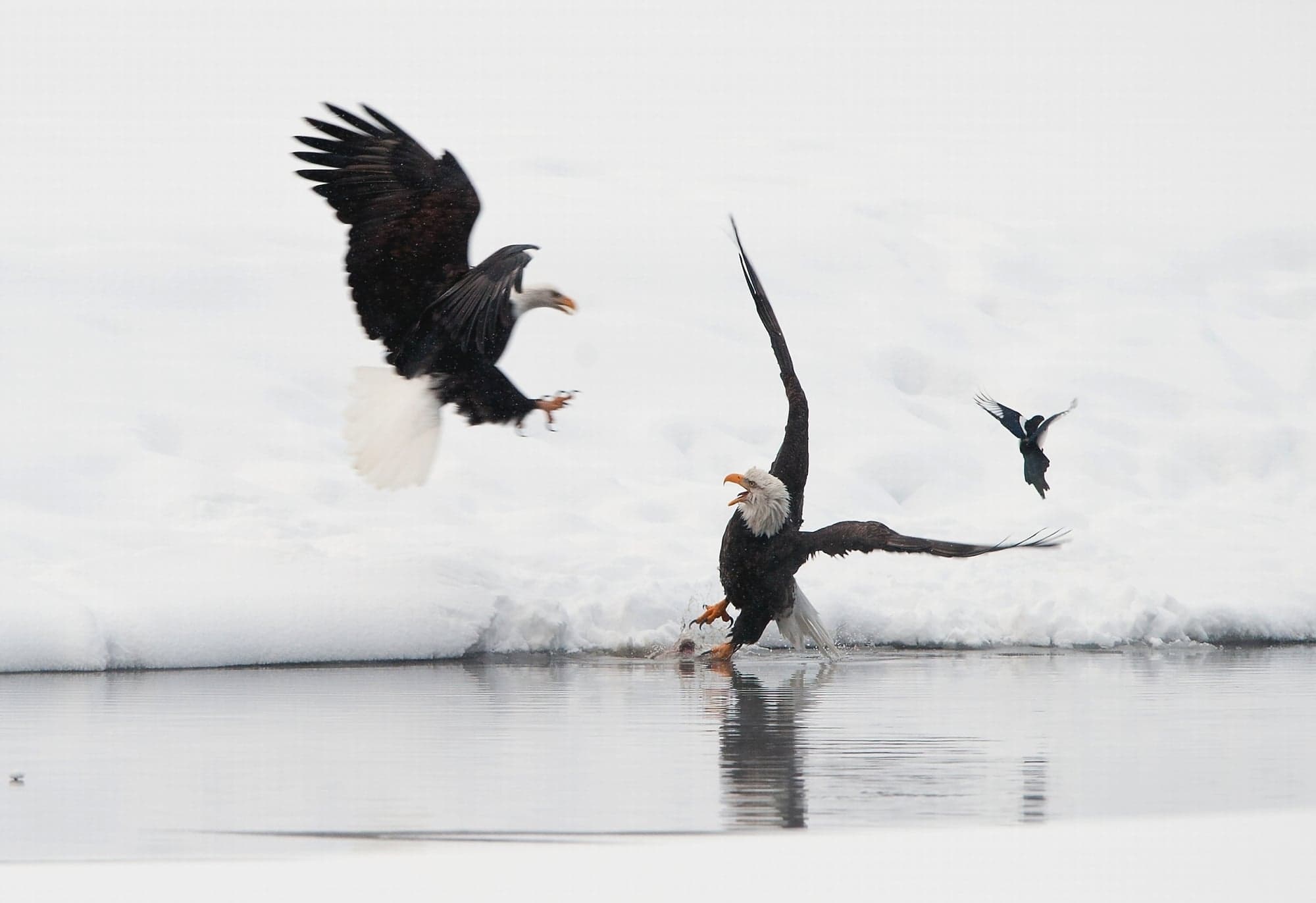
Before physical combat ensues, bald eagles typically engage in a series of warning displays designed to intimidate rivals without risking injury. These displays begin with posturing – an eagle will raise its feathers, particularly around the neck, to appear larger and more imposing. They may also open their wings partially while perched, maximizing their visual profile. Vocalizations play a crucial role as well, with eagles emitting their characteristic high-pitched, rapid series of notes that can be heard for considerable distances.
If these initial warnings fail to deter an intruder, the territorial eagle may perform fly-by intimidation tactics, swooping close to the rival without making contact. These preliminary behaviors serve an important evolutionary purpose, as they often resolve conflicts without physical confrontation, which could potentially injure both birds. Only when these warning systems fail does actual combat begin, indicating the high stakes of the dispute at hand.
Taking to the Air: The Combat Begins
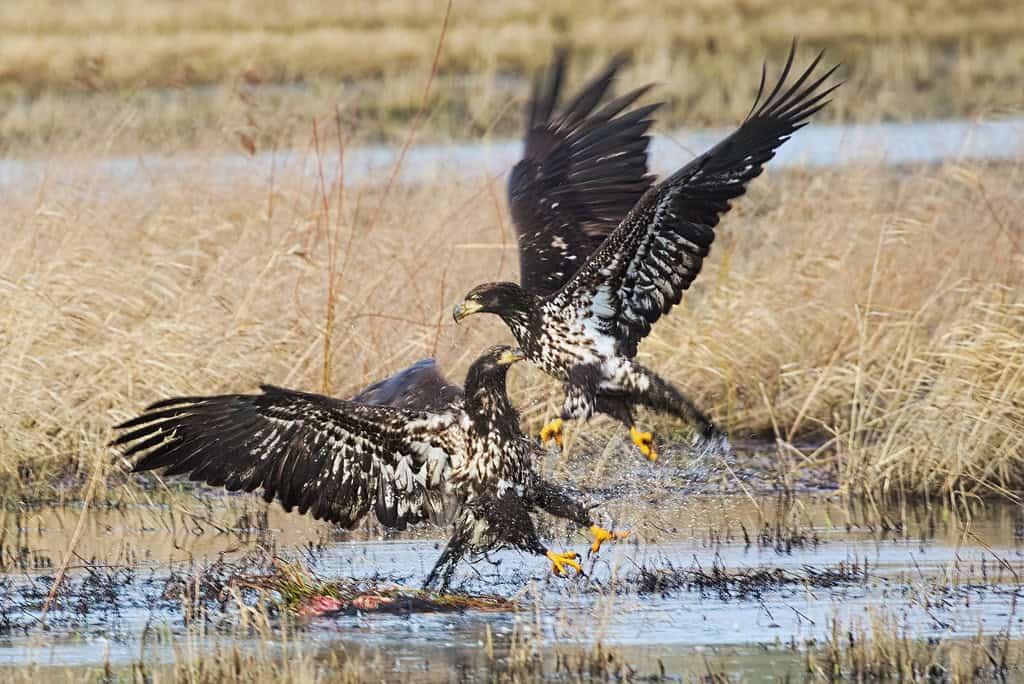
When warning displays prove insufficient, bald eagles escalate to physical confrontation. The transition to actual combat usually begins with both birds taking to the air, where their remarkable flying abilities come into play. Initially, eagles may circle each other, gaining altitude and positioning for advantage. With wingspans reaching up to 7.5 feet and exceptional maneuverability despite their 10-14 pound weight, these birds transform the sky into a three-dimensional battlefield.
During this preliminary phase, eagles constantly adjust their flight patterns in response to their opponent’s movements, demonstrating remarkable spatial awareness and tactical thinking. The birds typically try to gain the higher position, as altitude provides a significant advantage in aerial combat. This jockeying for position can continue for several minutes, with both birds ascending hundreds of feet while looking for the right moment to strike or force their opponent into a vulnerable position.
The Talon Grapple: A Signature Fighting Technique
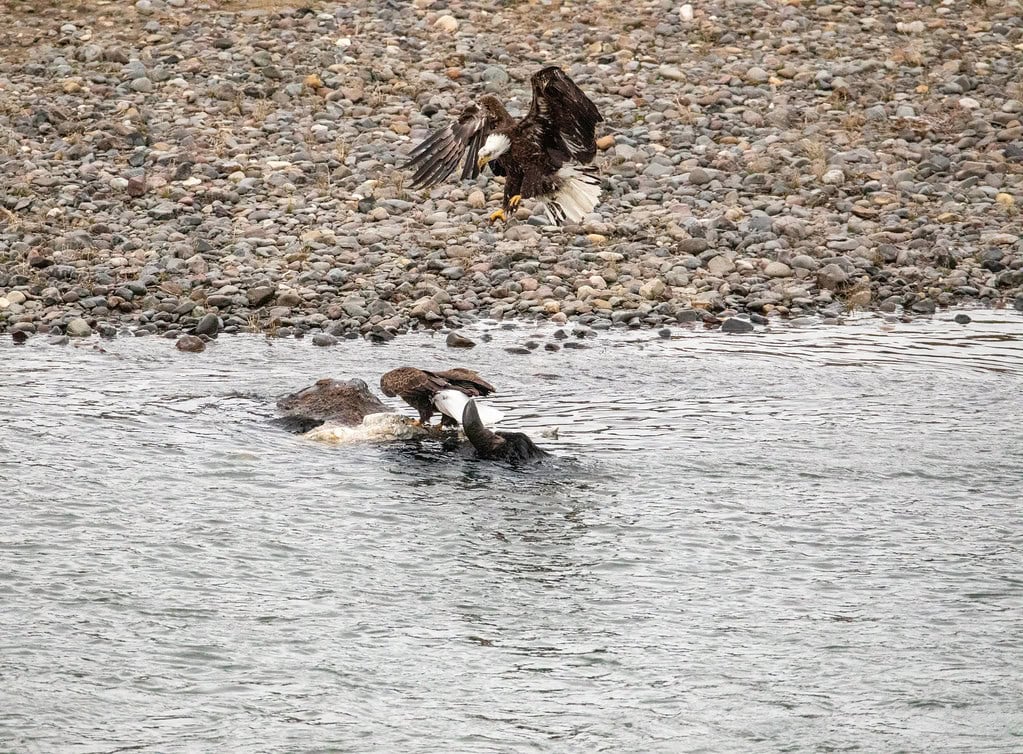
The most dramatic moment in eagle aerial combat is the talon grapple – a spectacular fighting technique where both birds lock talons in mid-air. This incredible maneuver begins when one eagle dives toward another, extending its powerful feet with talons outstretched. If the other eagle responds in kind, their talons may interlock, creating a connection that is both powerful and dangerous. With talons locked, the eagles begin to spin, creating a breathtaking cartwheel effect as they plummet toward the ground.
These talon grapples can be extraordinarily dangerous, as both birds are essentially in free-fall while connected. Their razor-sharp talons, capable of exerting up to 400 pounds per square inch of pressure, can inflict serious injuries. The birds typically separate before hitting the ground, though occasionally they maintain their grip too long and crash together. This risky behavior demonstrates just how high the stakes are in these territorial and mating disputes – eagles are willing to risk serious injury or even death to defend their territory or secure a mate.
Mid-Air Strikes and Dives
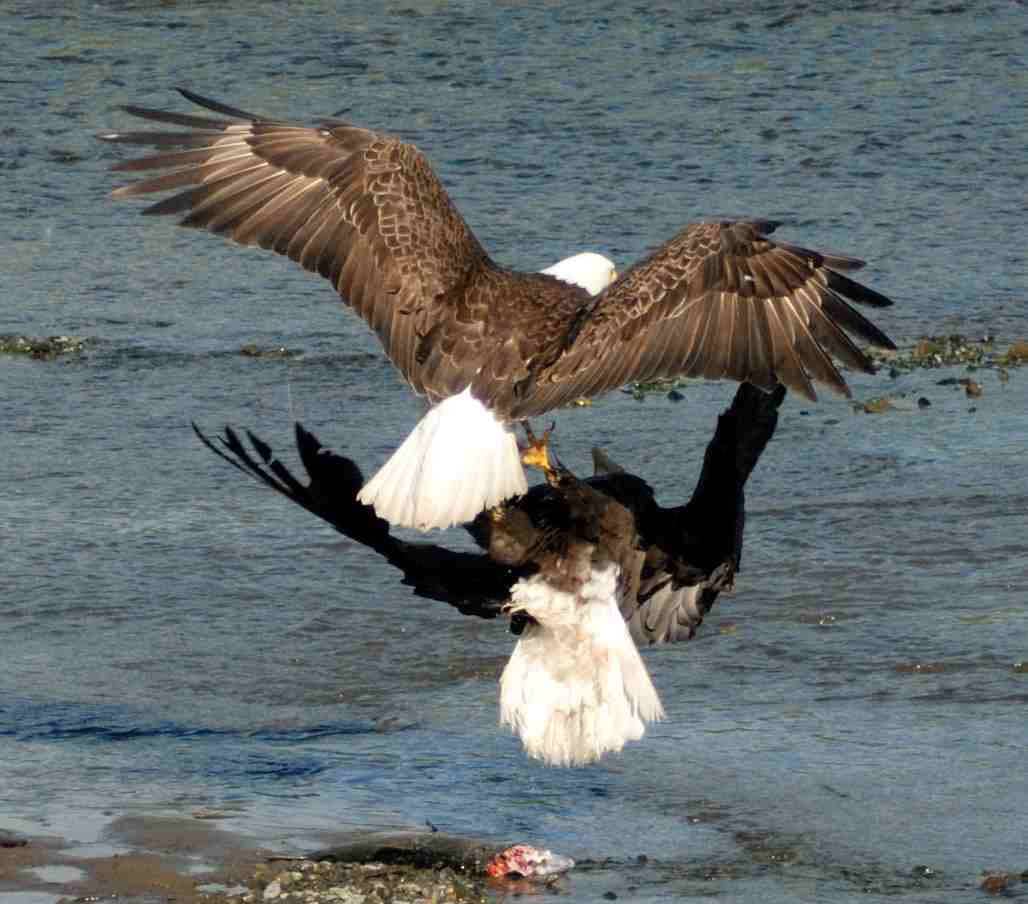
Beyond the spectacular talon grapple, bald eagles employ various other combat techniques during aerial battles. High-speed diving attacks are particularly common, with one eagle tucking its wings and plummeting toward its opponent at speeds that can exceed 100 mph. These stooping dives allow the attacking eagle to build momentum for a powerful strike, often aiming for the back or wings of its rival. The defending eagle typically responds with evasive maneuvers, rolling or swerving to avoid the attack.
Eagles also use their wings as weapons, delivering powerful blows that can knock opponents off balance mid-flight. While their beaks are formidable weapons on the ground or when feeding, they play a secondary role in aerial combat due to the mechanics of flight. The combination of diving attacks, wing strikes, and occasional direct talon swipes creates a dynamic and fluid combat style that leverages the eagle’s natural strengths and flying abilities. These battles can continue for extended periods, with both birds executing repeated attacks until one retreats or a decisive advantage is gained.
The Role of Vocalization During Combat
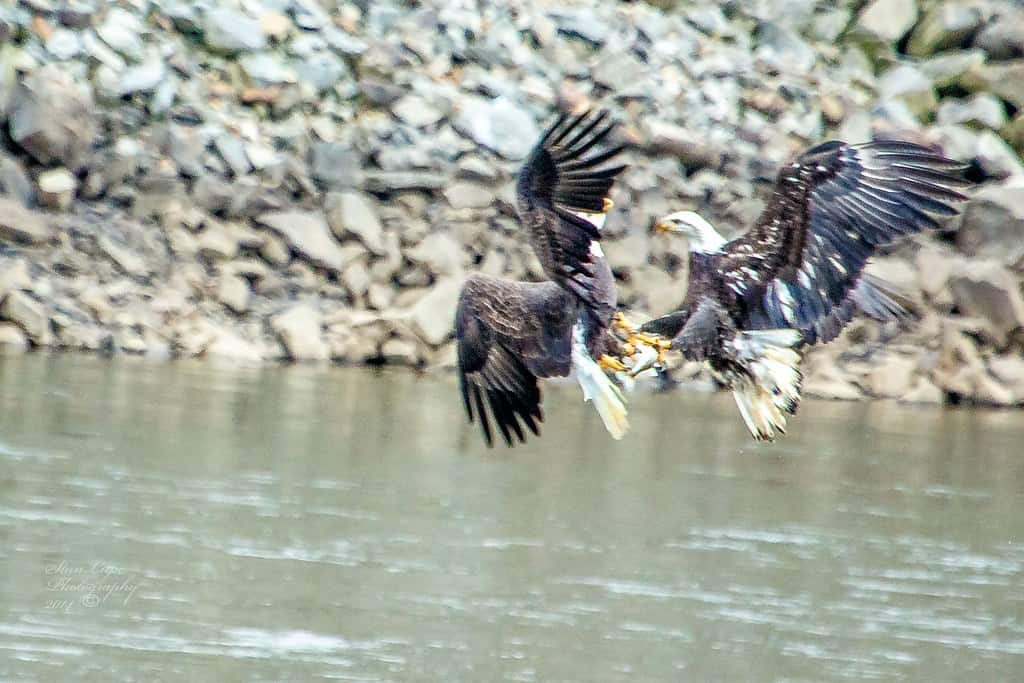
Throughout aerial combat, bald eagles communicate through distinctive vocalizations that serve multiple purposes. The iconic eagle scream (actually more of a high-pitched twitter or series of chirps in real life, different from the dubbed Hollywood scream often attributed to them) continues during flight, with varying intensity depending on the stage of the conflict. These calls can signal aggression, warn of an imminent attack, or communicate distress if injured.
Interestingly, mated pairs fighting together against an intruder will often coordinate their attacks through vocalizations, demonstrating their bonded relationship even in combat. Scientists studying these vocalizations have noted that the patterns change throughout the encounter, potentially conveying different messages as the conflict progresses. These calls also serve to reinforce territorial boundaries to other eagles in the vicinity, essentially broadcasting the outcome of the dispute across the landscape. The auditory component of eagle combat thus complements the visual spectacle, creating a multi-sensory experience that communicates vital information to both participants and observers.
Mate Defense: When Pairs Fight Together
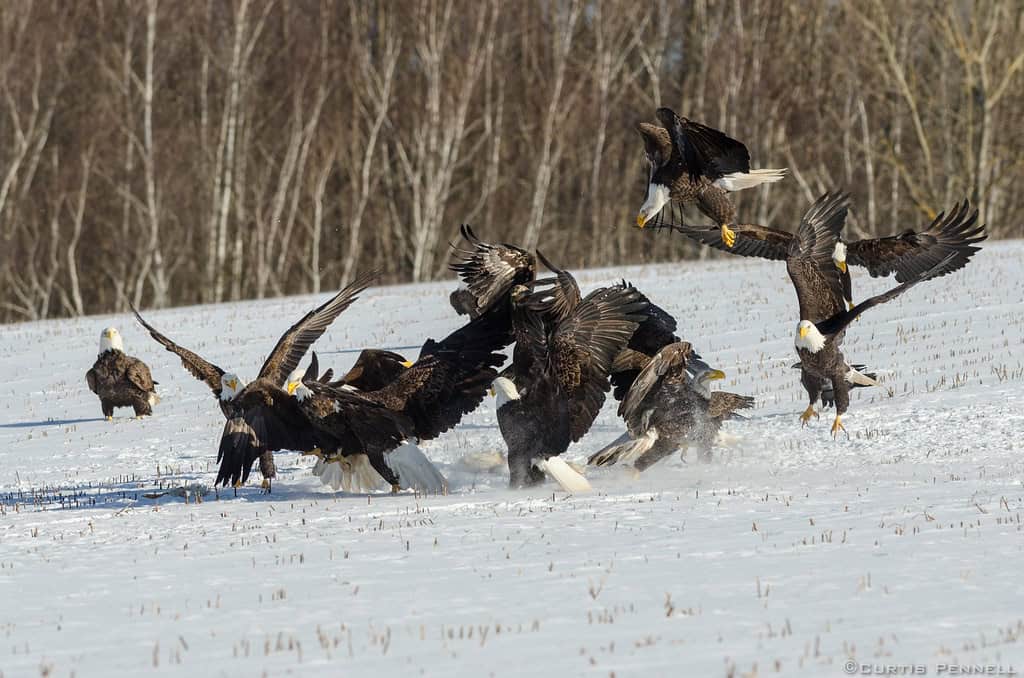
One of the most fascinating aspects of bald eagle aerial combat occurs when bonded pairs defend their territory together. Bald eagles typically mate for life, forming powerful partnerships that extend to cooperative defense strategies. When an intruder threatens their territory, both members of the pair may engage in coordinated attacks that demonstrate remarkable teamwork. One eagle might distract the intruder with frontal displays while the other positions itself for a rear attack, showing tactical coordination that maximizes their advantage.
This cooperative defense highlights the strong bond between mated eagles and provides significant advantages in territorial disputes. With two defenders working in concert, they can effectively control a larger territory and more successfully repel intruders. Researchers have observed that territories defended by pairs tend to remain more stable over time compared to those held by single eagles. This synchronized combat behavior also reinforces the pair bond, as the eagles engage in mutual defense of their shared interests – particularly important during nesting season when vulnerable eggs or eaglets are at stake.
Potential Injuries and Outcomes
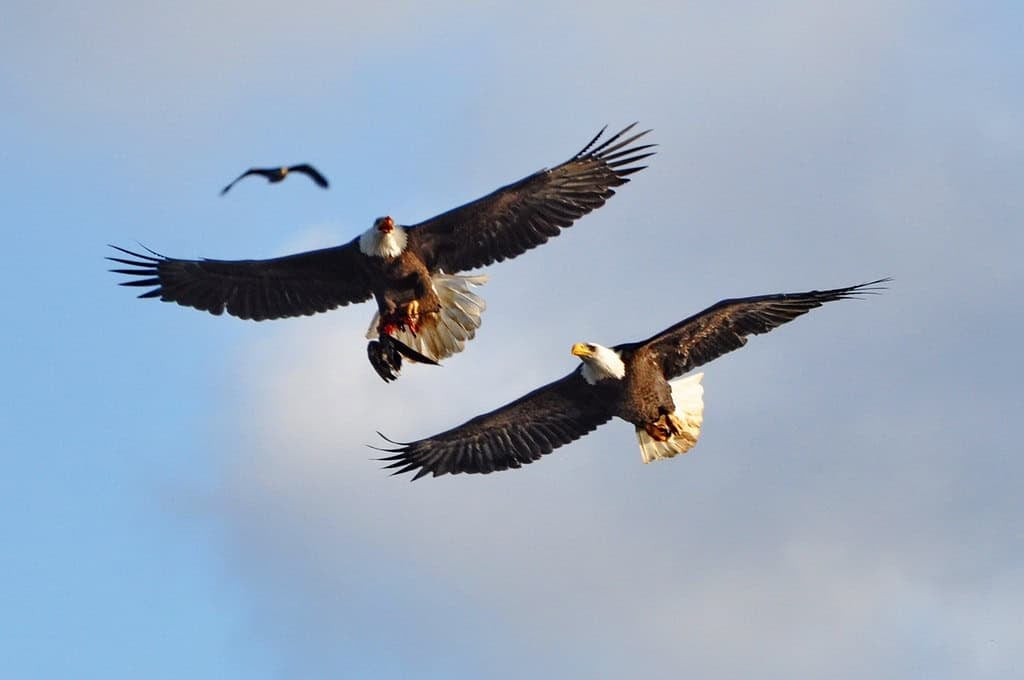
While aerial combat between bald eagles is visually spectacular, it carries significant risks for the participants. The most common injuries occur from talon punctures, which can damage muscles, pierce vital organs, or break bones if delivered with sufficient force. Wing injuries are particularly debilitating, as damage to flight feathers or wing bones can compromise an eagle’s ability to hunt effectively. Head injuries, though less common due to the eagles’ fighting style, can occur during particularly intense encounters and may prove fatal.
The outcomes of these aerial battles vary widely. Many conflicts end when one eagle clearly establishes dominance, forcing the other to retreat. However, more evenly matched opponents might fight to exhaustion, with both eventually disengaging without a clear victor. In rare cases, particularly during talon grapples that continue too long, both eagles may crash to the ground or water, potentially resulting in serious injury or drowning. Wildlife rehabilitators occasionally treat eagles with combat-related injuries, though many injured birds likely die without human intervention. These risks underscore the serious nature of these conflicts and the high value eagles place on territory and reproductive opportunities.
Seasonal Patterns in Eagle Combat
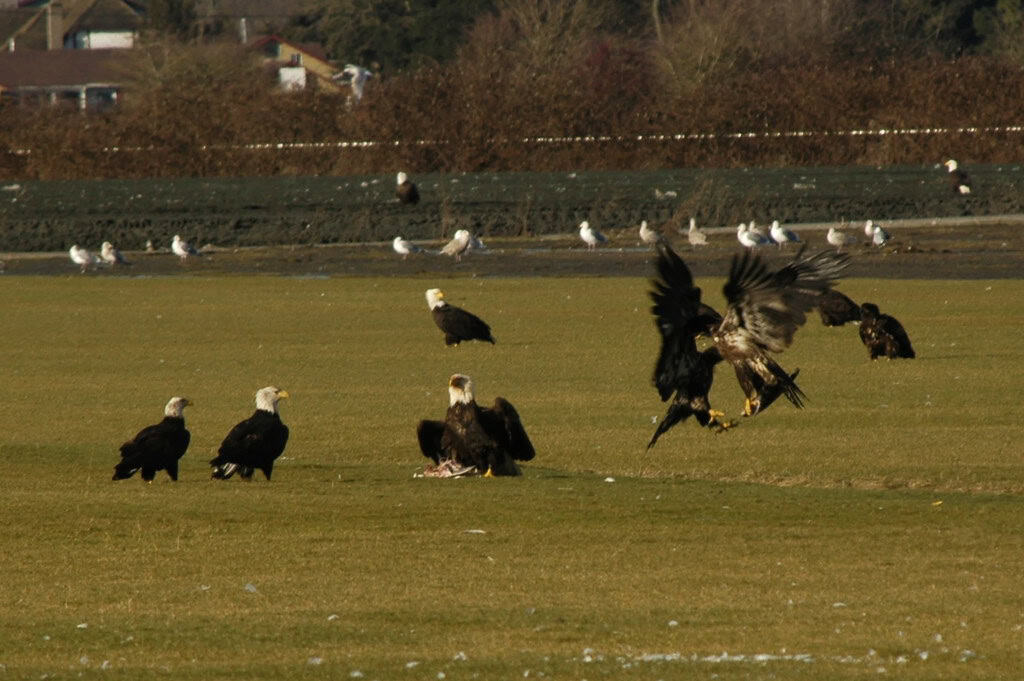
The frequency and intensity of bald eagle aerial combat follow distinct seasonal patterns tied to their breeding cycle. The most dramatic and frequent battles occur during the pre-breeding and early nesting season, typically from December through March in most regions. During this period, established pairs are reclaiming and defending nesting territories while unpaired eagles are seeking mates and attempting to establish new territories, creating numerous opportunities for conflict.
Combat frequency typically decreases during the late nesting and chick-rearing periods (April through July) as eagles focus their energy on feeding and protecting their young rather than territorial expansion. However, defense of the immediate nest area remains intense during this period, with parents aggressively driving off any perceived threats. Another peak in combat activity often occurs in late summer and fall when juvenile eagles are dispersing and testing territorial boundaries. Understanding these seasonal patterns helps researchers and wildlife observers anticipate when and where aerial combat is most likely to occur, providing opportunities to witness these remarkable events in the wild.
Geographic Variations in Fighting Behavior
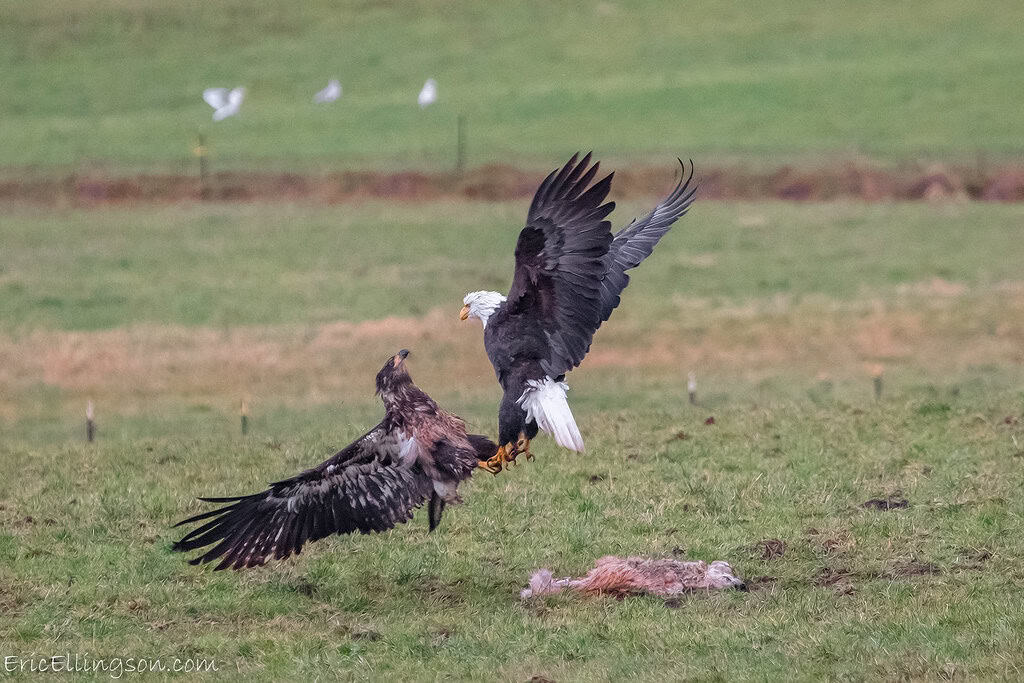
Interestingly, bald eagle combat behavior shows notable variations across different geographic regions, influenced by factors like eagle population density, food availability, and habitat characteristics. In areas with high eagle concentrations, such as Alaska’s salmon runs or the Chesapeake Bay region, combat tends to be more frequent but often less intense, as the abundance of food reduces the value of exclusive territories. Eagles in these regions have adapted to more communal feeding arrangements, though disputes still regularly occur.
By contrast, eagles in areas with more dispersed resources and lower eagle populations, such as parts of the Mountain West, tend to engage in less frequent but potentially more serious combat when it does occur. The stakes of territorial disputes are higher when resources are scarce. Coastal eagles also display different fighting strategies compared to their inland counterparts, often incorporating water landings into their combat repertoire. These regional variations highlight the adaptive nature of eagle behavior and how their fighting strategies evolve to match local environmental conditions and competitive pressures.
Witnessing Eagle Combat: A Rare Spectacle
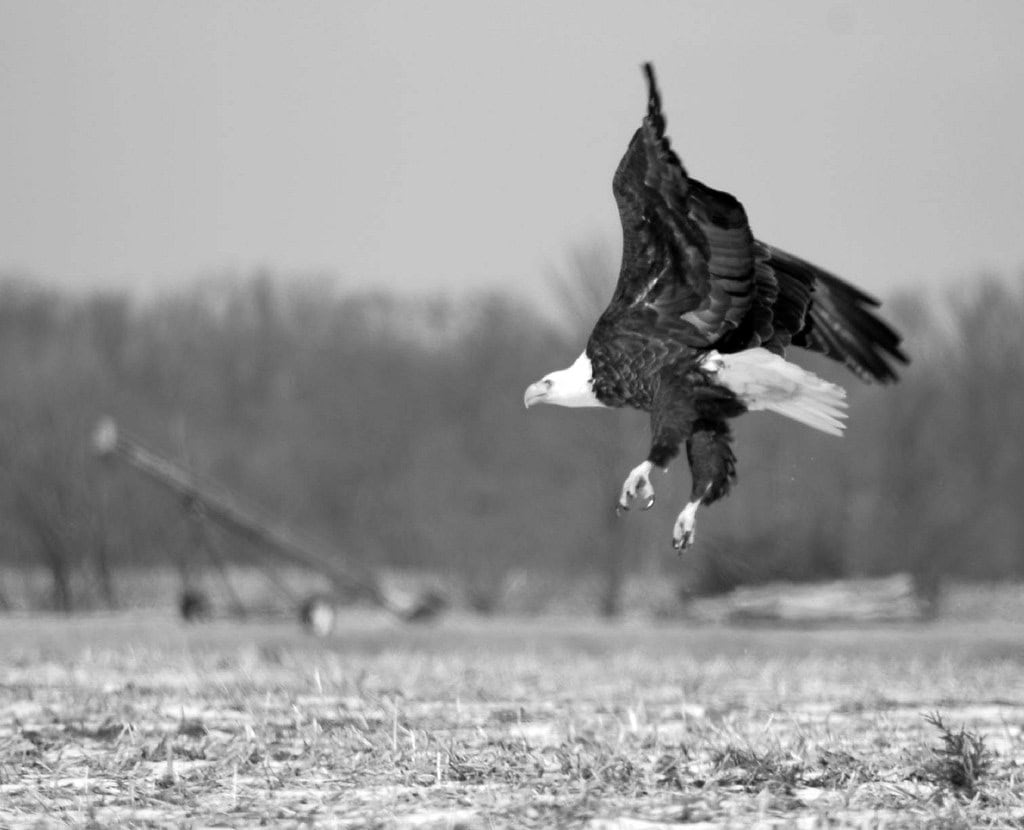
For wildlife enthusiasts and bird watchers, witnessing bald eagle aerial combat represents a rare and unforgettable experience. The best opportunities to observe these dramatic encounters occur in locations with high eagle concentrations during the pre-breeding season. Popular viewing sites include the Skagit River in Washington State, the Mississippi River around the Lock and Dam systems, and Alaska’s Chilkat Bald Eagle Preserve. At these locations, dozens or even hundreds of eagles may congregate, increasing the likelihood of territorial disputes.
When observing eagle combat, binoculars or spotting scopes are essential, as these encounters often occur at considerable heights. Patience is also crucial – the preliminary posturing and warning displays may last for extended periods before physical combat begins. Wildlife photographers hoping to capture these moments should use high-speed continuous shooting modes to catch the rapid action sequences. Many wildlife management agencies and conservation organizations offer guided eagle viewing tours during peak seasons, providing expert interpretation and improving the chances of witnessing these dramatic aerial battles in their natural context.
Understanding the Broader Significance

Aerial combat between bald eagles represents more than just a spectacular natural phenomenon – it plays a crucial role in eagle population dynamics and ecosystem health. These conflicts help distribute eagle territories across the landscape in patterns that balance population density with resource availability. The outcome of combat encounters influences which eagles secure the best territories and breeding opportunities, creating a form of natural selection that may favor the strongest, most skilled individuals.
For researchers, observing combat behaviors provides valuable insights into eagle communication, social structure, and problem-solving abilities. These encounters demonstrate the complex decision-making processes these birds employ when weighing the risks of combat against the potential rewards. The patterns of eagle distribution that emerge from these territorial disputes also help wildlife managers identify critical habitat areas for protection. By understanding the dynamics of eagle combat, conservationists can better predict how populations might respond to habitat changes or management interventions, ultimately supporting more effective protection for these iconic birds.
Conclusion: The Sky as Battlefield

When bald eagles fight in the sky, they transform the open air into a dynamic battlefield where strength, skill, and strategy determine the outcome. These aerial confrontations reveal much about eagle behavior, from their territorial instincts and resource competition to their remarkable physical capabilities and problem-solving intelligence. While visually spectacular for human observers, these battles represent deadly serious business for the eagles involved, with significant consequences for their survival and reproductive success.
The dramatic nature of eagle combat reminds us of the intense competitive pressures that shape wildlife behavior, even in species we might view as symbols of freedom and majesty. As bald eagle populations continue to recover across North America following their near-extinction in the mid-20th century, opportunities to witness these aerial battles will likely increase. Each spectacular confrontation serves as a powerful reminder of the wild spirit and fierce determination that have made the bald eagle an enduring national symbol and a conservation success story worth celebrating.
- What Happens When Bald Eagles Fight in the Sky? - August 11, 2025
- From Coyotes to Roadrunners: Wild Faces of the American Desert - August 11, 2025
- Why Capybaras Are the Most Chill Animals on Earth - August 11, 2025

